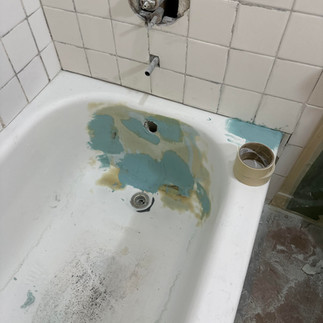Why is it advisable to remove hardware such as the faucet, drain, and shower doors before refinishing?
- bathtubreglazingsp
- Jan 4
- 2 min read
Updated: Aug 23
As a refinishing company, we are not licensed to remove any hardware such as faucets
or drains from bathtubs or tiles, as this is not within our trade of expertise. It is important
to remove the hardware like drains, faucets, overflows, and shower doors to prevent
them from tarnishing. Most hardware can be easily removed by the homeowner.
Depending on where you live, especially in condo-style properties, it may be difficult to
remove the drain if it is corroded and might cause further damage. In such cases, we
can simply mask the hardware. Some clients may not have the means to remove it, so
their only option is to mask it. Others may not want to spend extra time or money to do
so, and we understand their situation. However, in the long run, deterioration of the
finish around the drain and overflow can definitely be anticipated, and we are not
responsible for it.
If your hardware is removed, the coating can be sprayed on the entire surface. Once
you reinstall the hardware, the coating will be underneath, sealing the refinished
surface. As a result, this will enhance the surface's durability.
Depending on the color of your hardware, removing it is highly recommended,
especially if it is gold or rose-colored. If your hardware is gold or nickel, we strongly
advise you to remove it because we will need to etch the tub and tile. Although we will
mask and protect your hardware if you choose not to remove it, the etching substance
can evaporate and penetrate the hardware, causing it to appear tarnished and
discolored. This damage will be permanent and cannot be cleaned. Therefore,
refinishers cannot be held responsible for any tarnishing that occurs if the hardware is
not removed.
Regarding the shower doors, they can sometimes be easily removed, while the frames
can be left behind and masked if the homeowner decides to keep them. Just like the
hardware, we will mask the frames. Although they are masked, there is a higher chance
they can be damaged due to the etching process.
Additionally, we are limited in how much silicone we can remove from around the frame,
as silicone is previously applied to the shower doors to help secure them. This limitation
provides us with less space to work around the bathroom if the shower door itself is not
removed. Sometimes, it actually hinders us from completing the work, making it
inconvenient for both the technician and the homeowner, as it may require the shower
door to be removed and the job rescheduled if the hardware is blocking our way inside
the bathroom.
Therefore, if you are planning to schedule a refinishing in the bathroom, it is advisable
to remove hardware such as drains, faucets, and shower doors. This will allow for better
sealants, enabling the entire surface to be sprayed and avoiding further damage to your
hardware.
Also, keep in mind that if you are refinishing the entire bathroom, it is not only advisable
to remove the hardware, but we also suggest removing the toilet and vanity. This way,
the entire tile walls can be sprayed without leaving any tiles behind the toilet or vanity.
Do this removal prior to your refinishing schedule and plan ahead.
.png)








Comments